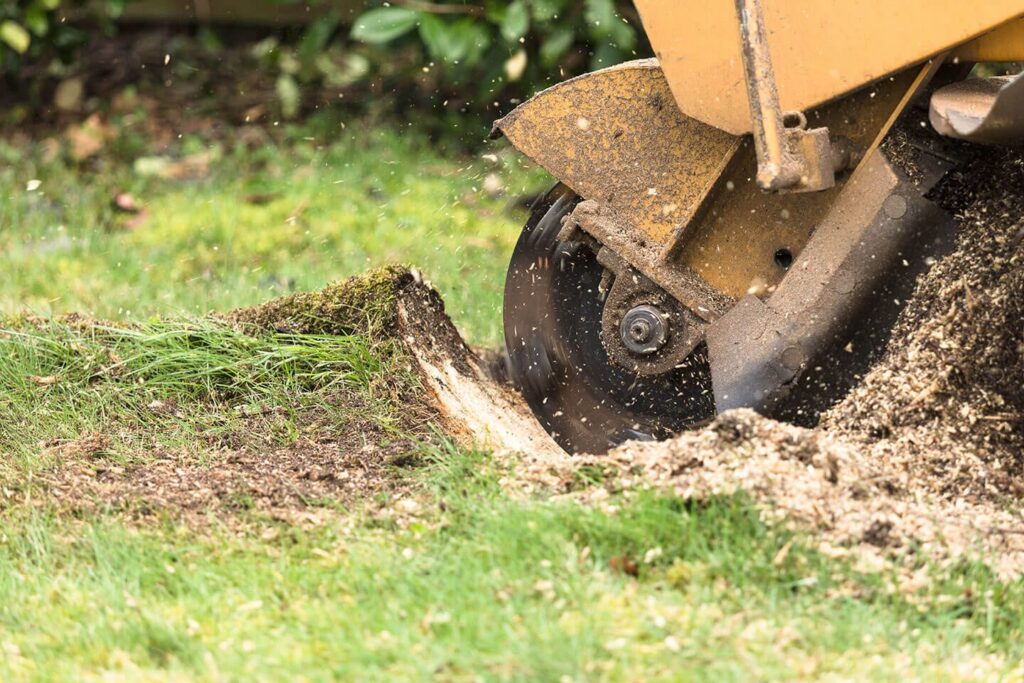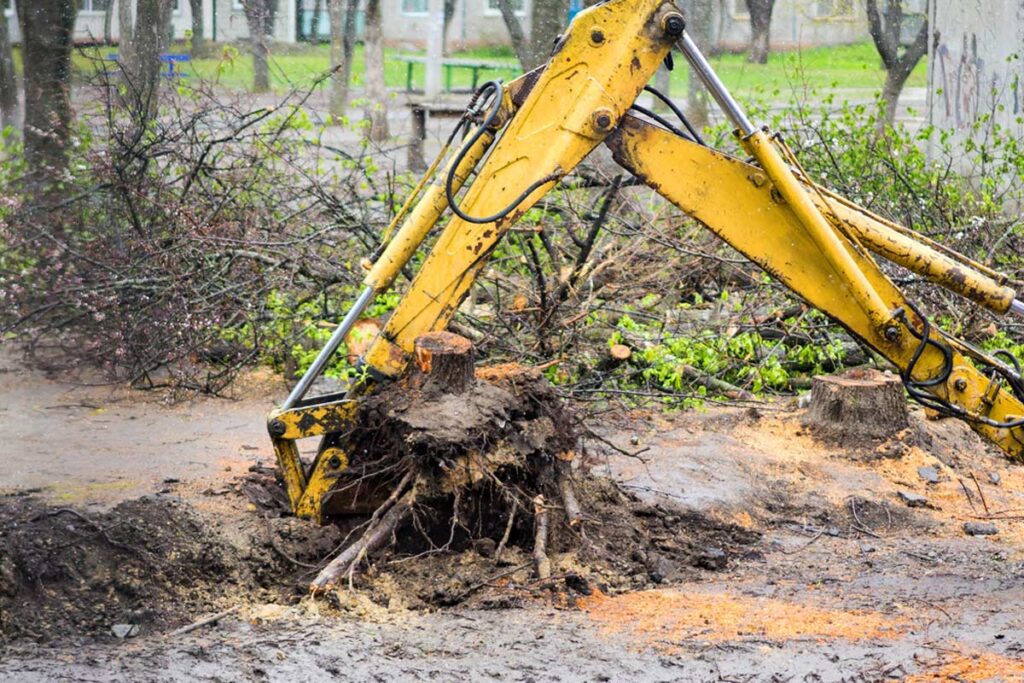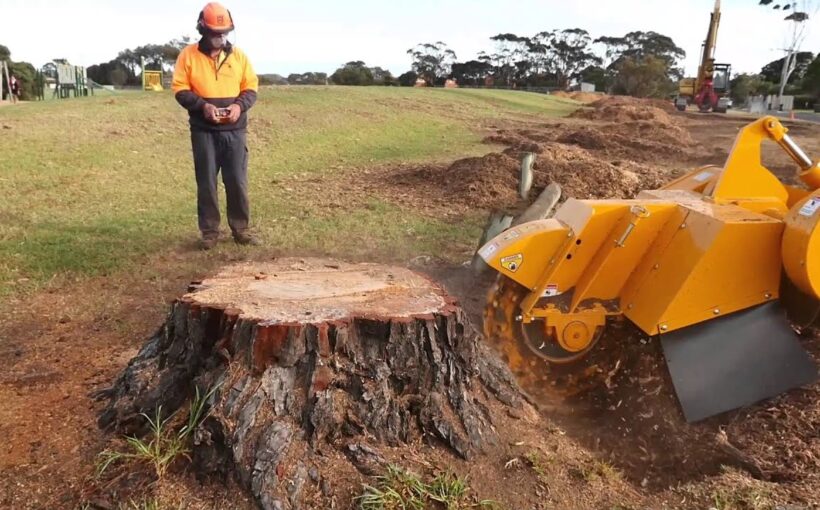Tree stumps are often left behind after a tree has been cut down, whether intentionally or unintentionally. While some may consider them harmless, tree stumps can actually cause a variety of issues if left unattended.
In this article, we will explore the importance of tree stump removal, the different methods available, factors to consider when choosing a method, and the role of professionals in stump removal.
Understanding the Importance of Tree Stump Removal
When a tree is cut down, the stump that remains may seem inconspicuous at first. However, leaving tree stumps in your yard can have significant implications for the environment, safety, and property value.
Tree stump removal is not just about aesthetics; it plays a crucial role in maintaining a healthy ecosystem in your yard. By removing tree stumps, you eliminate potential breeding grounds for pests like termites, ants, and beetles. This proactive step helps protect the health of your remaining trees and prevents the spread of damaging insects throughout your landscape. Learn more why tree stump removal matters.
Environmental Implications of Leaving Tree Stumps
Leaving tree stumps in your yard can have negative environmental effects. Stumps can act as breeding grounds for pests, such as termites, ants, and beetles. These pests can then spread to healthy trees and cause further damage to your landscape. Additionally, tree stumps can impede the growth of new plants and trees by taking up valuable space and nutrients in the soil.
Furthermore, decaying tree stumps release carbon dioxide into the atmosphere as they break down, contributing to greenhouse gas emissions. By removing tree stumps, you can help mitigate this environmental impact and promote a healthier, more sustainable ecosystem in your yard.
Safety Hazards Posed by Tree Stumps
Tree stumps can pose safety hazards, especially if they are not easily visible. They can cause trips and falls, leading to injuries for both adults and children. Moreover, tree stumps can damage lawnmowers and other yard maintenance equipment if accidentally hit, resulting in costly repairs.
Additionally, hidden tree stumps can create obstacles for children playing in the yard or guests walking around your property. Removing tree stumps ensures a safer environment for everyone and reduces the risk of accidents or injuries caused by these hidden hazards.
Aesthetic and Property Value Considerations
Aside from the functional aspects, tree stumps can also impact the aesthetics of your property. They can be eyesores, detracting from the overall appearance of your landscape. Additionally, when it comes time to sell your property, potential buyers may view tree stumps as a negative feature that reduces the value of your home.
By investing in tree stump removal, you not only enhance the visual appeal of your property but also increase its market value. A well-maintained yard free of unsightly tree stumps is more attractive to potential buyers and can help you maximize the return on your property investment in the long run.
Different Methods of Tree Stump Removal
Fortunately, there are various methods available for removing tree stumps. Each method has its advantages and considerations, depending on factors such as the size and age of the stump, soil condition, and personal preferences.

Chemical Stump Removal Techniques
Chemical stump removal involves the use of specific chemicals to break down the stump over time. This method is suitable for smaller stumps and involves drilling holes into the stump and applying the chemicals. Over a few weeks, the stump will decay, making it easier to remove manually or by grinding.
One important consideration when using chemical stump removal techniques is the potential impact on the surrounding vegetation. The chemicals used in this process can affect the soil’s pH levels, which may harm nearby plants and trees. It is crucial to carefully follow the instructions provided with the chemicals and take necessary precautions to protect the environment.
Manual Stump Removal Techniques
If you prefer a more hands-on approach, manual stump removal techniques can be utilized. This method involves the use of tools such as axes, mattocks, and shovels to dig around the stump and expose its roots. The roots can then be cut and removed, allowing for the extraction of the stump. Manual removal is best suited for smaller stumps and requires physical effort and perseverance.
When using manual stump removal techniques, it is essential to exercise caution and wear appropriate protective gear. The use of sharp tools and the physical exertion involved in digging can pose risks, such as cuts and strains. Additionally, it is crucial to be mindful of any underground utilities or pipes that may be present in the area to avoid accidental damage.
Grinding as a Stump Removal Method
Stump grinding is a popular method for removing tree stumps, especially for larger stumps. This technique involves using a stump grinder, a heavy-duty machine that has a rotating cutting wheel with sharp teeth. The grinder is positioned over the stump and works by grinding it into small wood chips. The wood chips can then be used as mulch or removed from the area.
One advantage of stump grinding is that it provides a relatively quick and efficient way to remove stumps. However, it is important to consider the noise and vibrations generated by the grinding process, which may be disruptive to nearby residents or sensitive structures. It is advisable to inform neighbors in advance and take necessary precautions to minimize any potential disturbances.
Burning: An Effective Stump Removal Technique
Burning is another effective method for removing tree stumps, particularly in areas where open burning is allowed. This technique involves drilling holes into the stump, filling them with fuel or accelerant, and igniting it. The fire will break down the stump over time, turning it into ash. However, caution must be exercised when using this method to ensure it complies with local regulations and safety guidelines.
When using burning as a stump removal technique, it is crucial to consider the environmental and safety implications. Open burning can release pollutants into the air and may pose a fire hazard if not properly controlled. It is essential to check with local authorities and obtain any necessary permits before attempting this method. Additionally, it is important to have fire extinguishing equipment readily available and to monitor the burning process closely to prevent any unwanted incidents.
Factors to Consider When Choosing a Stump Removal Method
Before deciding on a stump removal method, several factors should be considered to ensure the most suitable approach:
Evaluating the Size and Age of the Stump
The size and age of the stump can influence which method is most appropriate. For large and older stumps, grinding or burning may be the most effective options. Smaller and younger stumps are often manageable through manual removal or chemical techniques.
When dealing with a large stump, it’s essential to consider the root system’s extent beneath the ground. Older trees tend to have more extensive root systems, making complete removal more challenging. In such cases, grinding may be preferred as it can reach deeper into the ground to eliminate the stump and roots effectively.
Assessing the Soil Condition and Surrounding Area
The condition of the soil and the surrounding area is crucial when choosing a stump removal method. For instance, grinding is a better choice if you plan to replant trees or vegetation in the same area since it produces smaller wood chips that can be easily incorporated into the soil. Chemical methods, on the other hand, may not be suitable if you have specific soil or environmental concerns.
Moreover, the presence of underground utilities or nearby structures can impact the choice of removal method. In areas with utility lines or close proximity to buildings, manual removal or grinding may be safer options to avoid any damage. It’s important to assess the entire site thoroughly before proceeding with any stump removal technique.
Cost and Time Considerations
The cost and time involved in stump removal should also be considered. Grinding and manual removal are generally quicker and less time-consuming than chemical methods, which can take several weeks or even months to fully decompose the stump. The cost can vary depending on factors such as the size and accessibility of the stump, equipment rental, or professional services if requested.
Additionally, the disposal of stump debris should be factored into the overall cost. While grinding produces mulch that can be used as a beneficial soil amendment, other methods may require additional expenses for hauling away the remnants. Considering the long-term effects on your property and budget is essential when selecting the most suitable stump removal approach.

The Role of Professionals in Tree Stump Removal
While some homeowners may choose to tackle stump removal themselves, there are instances where hiring professionals is the wiser choice. Professionals have the experience, knowledge, and specialized equipment necessary to efficiently and safely remove tree stumps.
When to Hire a Professional for Stump Removal
Consider hiring a professional stump removal service if:
- You have multiple large stumps that require removal
- The stumps are located near structures, utility lines, or other sensitive areas
- You lack the physical ability or expertise to remove the stumps independently
Benefits of Professional Stump Removal Services
Professional stump removal services offer several benefits:
- Efficiency: Professionals have the necessary equipment and expertise to complete the job efficiently.
- Safety: Professionals follow safety protocols to minimize the risk of accidents during stump removal.
- Cleanup: They will remove all debris and wood chips, leaving your yard clean and tidy.
- Expert Advice: Professionals can provide guidance on future landscaping or tree planting options.
But what exactly does the process of professional stump removal entail? Let’s dive into the details.
When you hire professionals for stump removal, they will typically begin by assessing the situation. They will carefully examine the stumps, taking into consideration their size, location, and any potential obstacles in the surrounding area. This assessment allows them to develop a strategic plan for the most effective removal.
Once the plan is in place, the professionals will bring in their specialized equipment. Depending on the size and accessibility of the stumps, they may use a variety of tools such as stump grinders, chainsaws, or excavators. These tools are specifically designed to make the removal process as efficient as possible.
During the actual removal, the professionals will take all necessary precautions to ensure safety. They will wear protective gear, follow proper techniques, and use their expertise to avoid any damage to nearby structures or utility lines. Safety is their top priority throughout the entire process.
Once the stumps are successfully removed, the professionals will not leave you with a messy yard. They take pride in their work and will thoroughly clean up the area, removing all debris and wood chips. You can expect a clean and tidy yard once they are done.
Furthermore, professional stump removal services can provide you with valuable advice for your future landscaping endeavors. They have extensive knowledge about trees and plants, and can recommend suitable options for your specific needs. Whether you want to replace the stumps with new trees or create a different landscape design, their expert guidance can help you make informed decisions.
In conclusion, tree stump removal is necessary to avoid environmental implications, safety hazards, and aesthetic issues. The choice of stump removal method depends on various factors such as stump size, soil condition, and personal preferences. Hiring professionals can ensure a safe and efficient removal process. By taking the necessary steps to remove tree stumps, you can enhance the appearance and value of your property while promoting a healthier and safer environment.
